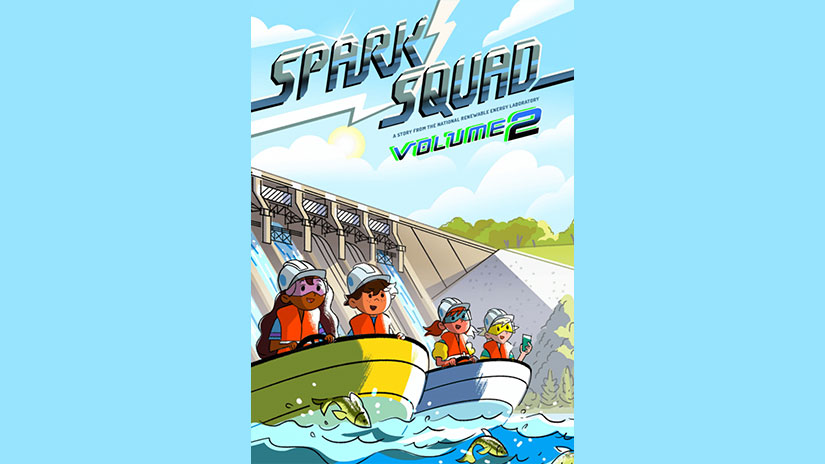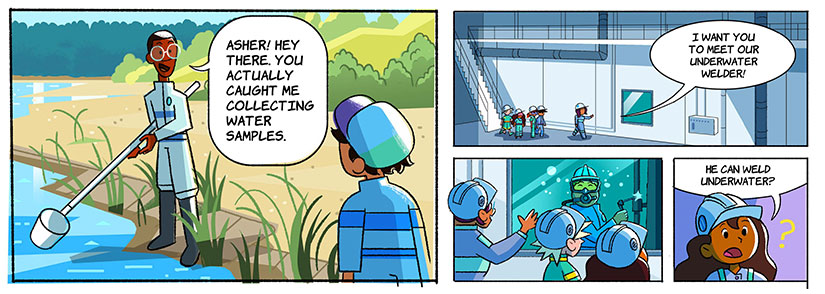Does Hydropower Have an Invisibility Problem?
How Misconceptions and Hidden Benefits Can Disguise This Unsung Hero—and What Three Hydro-Hypers Are Doing To Fix the Problem

To find the Richard B. Russell Dam, hydropower hunters must follow a slim two-lane country road through Georgia evergreens. The road, apart from a few soft curves, looks the same. Even the trees look the same. There is just one hint that something powerful sits within this wilderness. Every so often, the trees part to allow transmission lines to sweep across the road.
Unlike rooftop solar panels or hill-hugging wind turbines, hydropower plants are often hidden in our landscapes and even our minds. And yet, as the country transitions to clean energy, these plants will be the dependable partner that more visible—and variable—energy sources need to produce steady, clean power.
“It’s the unsung hero quietly keeping the lights on,” said Jennifer Daw, a water power group manager and senior researcher at the National Renewable Energy Laboratory (NREL).
Daw, along with NREL’s Elise DeGeorge and Michael Ingram, are eager to make hydropower visible again—not only because of the key role it will play in a resilient clean energy grid, but also because the industry’s workforce is facing a flood of retirements. The renewable sector needs a new generation of diverse workers to keep these hidden resources running. But how do you entice people—from young kids to college students or even folks working parallel jobs—to join a hidden industry?
“We’re trying to make hydropower more visible,” Daw said.
Put another way: “We need to give hydro a lot more tentacles and find more hydro-inclined people with our octopus,” said DeGeorge, a project leader for wind and water power workforce development at NREL.
Recently, the trio added another tentacle to the hydroctopus: a hydro-themed edition of the Spark Squad Comic Book series, which follows a troupe of precocious kiddos as they explore different types of renewable energy. In the first edition, which was invented by an adult spark squad, the kids use wave energy to power a boat through a violent storm. For the hydropower edition, the squad takes a road trip to Georgia to visit the Richard B. Russell Dam and Lake.
"Hydropower—it has to be more than just a dam," one kid muses in the comic’s first panels. "Right?"

When workers at the Russell Dam and Lake learned their facility was featured in the Spark Squad Comic Book, “they were so excited,” Jennifer Daw said. “A lot of hydropower workers are quietly doing their jobs and saving the world with hydro.” Graphic by Chromosphere
If hydropower does cross someone’s mind, it is often as a big dam, like the Hoover Dam. Recently, an NREL intern asked Daw if today’s hydropower work is exclusively focused on dam removal. “I’m curious,” Daw responded. “Why would you think that?” That is what his environmental engineering courses happened to focus on: the historical impact of big dams.
Daw acknowledges that hydropower’s history has not always been rosy. Some past projects did not consider the best interests of local communities or ecosystems. “Some of these dams were built by just bulldozing and building,” Daw said.
And while some of those dams were not built with the community or environment in mind, today’s modern, low-impact hydropower technologies and plants—and yes, dams—can help protect communities and the environment. Many—including the one the Spark Squad visits—employ biologists to monitor the health of their local environment and provide ladder-like structures that help fish move around the dam and migrate downstream. Pumped storage hydropower facilities (or water batteries, as the comic calls them) can store hours' worth of energy and could be the most sustainable energy storage option.
And, because hydropower plants can both store energy and help quickly integrate more renewable energy into the grid, they are essential to fight our largest environmental foe: climate change.
“The misperceptions of the hydropower industry get in the way of people seeking it,” Daw said.
“It’s probably one of the best-kept secrets as far as jobs go,” added Ingram, a chief engineer at NREL who has spent decades researching and working in hydropower. Ingram remembers one day when he was working at a Tennessee pumped storage hydropower facility, and a nearby nuclear energy plant shut down unexpectedly. “Boom,” he said “you replace that lost electricity with water in a matter of seconds. I’m a nerd engineer, and that sends chills up my neck. That’s one of the things that hydropower brings to the grid that people just don’t appreciate.”

All three hydro aficionados have stories about people who stumbled into the industry. DeGeorge remembers a young woman who took a job at a campground so she could paddleboard all summer. A nearby hydropower plant provided a reservoir to pursue her paddling, and “lo and behold,” DeGeorge said, she eventually took a job at the plant. Even Daw’s skeptical intern asked her for a list of hydropower internships he could pursue.
Daw said she hears lots of hydropower workers say, “Hydro found me.” “Hydro can totally find you,” she said. “But that’s not a great recruiting strategy.”
In their Spark Squad Comic Book, the trio tried to show how diverse hydropower jobs can be. An underwater welder fixes a fish deterrent system. The plant engineer (who is modeled on DeGeorge) explains how hydropower can help with flood control. And Uncle Frank, a biologist, collects water samples to make sure the reservoir is healthy.
Maybe a comic book is too kiddie for some up-and-coming hydropower workers (although, at recent conferences, printed versions got snatched up quickly, and the virtual version went viral). But DeGeorge also runs the Hydropower Collegiate Competition, which is funded by the U.S. Department of Energy’s Water Power Technologies Office. And she helps design career maps to guide aspiring workers into the industry.
“You can't just talk to the student,” DeGeorge said. “You have to reach the communities.”
All this outreach, she continued, “is just a first step.”
Check out the Spark Squad Comic Book, and discover all the ways NREL’s experts are inspiring the next generation of clean energy champions to save the planet. And subscribe to the NREL water power newsletter, The Current, for the latest news on NREL's water power research.
Last Updated May 28, 2025
